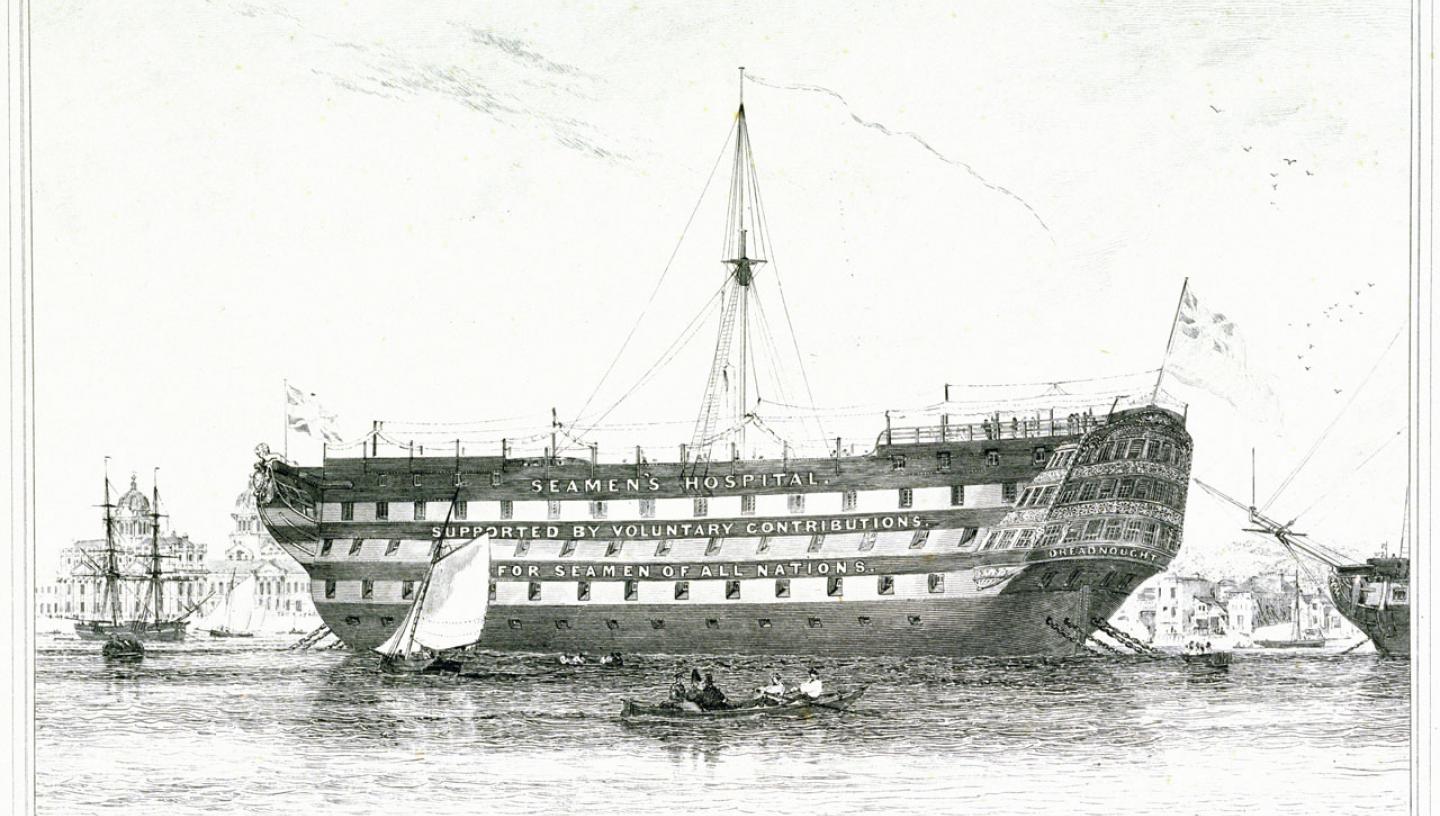
A new project at Royal Museums Greenwich aims to open up records of the Dreadnought Seamen’s Hospital, a floating hospital at the heart of 19th century Greenwich.
In this blog we take a look at the Arts and Humanities Research Council (AHRC) funded collaborative research project titled HMS NHS: The Nautical Health Service and the importance of digital and online volunteer projects to make Archive and Library records more widely accessible to the public.
The Nautical Health Service
September will see the launch of a new Royal Museums Greenwich digital research and transcription project, HMS NHS: the Nautical Health Service, as part of the wider project Engaging Crowds: Citizen research and heritage data at scale.
Engaging Crowds is a two-year AHRC funded collaborative research project, run in partnership with The National Archives, Royal Botanic Garden Edinburgh, and crowdsourcing platform provider Zooniverse, based at the University of Oxford. The project looks at online volunteering in the heritage sector.
In recent years volunteering has become an essential part of the tasks museums and heritage organizations do, from listing and describing uncatalogued materials, enhancing and updating older catalogue entries to complete transcription projects in their own right, making large numbers of previously unavailable records accessible online for the first time.
But what makes a good project successful, fun and rewarding, and what are the common issues that make volunteers decide a project is not for them?
With three different online volunteer archival transcription projects, Engaging Crowds aims to offer volunteers choices in how they tackle online transcription tasks, and seeks to gather data on the choices made and incorporate the findings into future transcription tools.
The National Archives’ project Scarlets and Blues, transcribes selected entries from meeting minute books of the Royal Hospital Chelsea Pensioners during the First World War, while the Royal Botanic Garden Edinburgh’s project looks at collections of plant samples. The Royal Museums Greenwich project uses the records of the Dreadnought Seamen’s Hospital, which operated in Greenwich from 1826-1977.
The Dreadnought Seamen’s Hospital, Greenwich
The Dreadnought Seamen’s Hospital at Greenwich was the main clinical site of the Seamen’s Hospital Society (now Seafarers Hospital Society), founded with the philanthropic mission of providing relief to sick and injured seafarers of all nations.
Throughout the period 1821-1870 it was a floating hospital, based in three successive converted warships, one of which, HMS Dreadnought, veteran of the battle of Trafalgar, gave the hospital its name. It then moved on land and until 1986 occupied the buildings which are now a student hub for the University of Greenwich. For over 150 years, the Dreadnought hospital was the principal hospital for mariners entering or leaving the Port of London, providing treatment and relief to merchant seamen from all over the world.
Seamen’s medical records at the Caird Library
The records now held by the National Maritime Museum’s Caird Library record name, age and place of birth, together with rank, employer and the name of the last ship the mariner served on. Medical information includes dates of admission and discharge, medical issue, injury or complaint, together with how the patient responded to treatment and whether they returned to a ship fit for duty, died or needed further treatment. The patients were seafarers from all over the globe, reflecting the international traffic of the Port of London. Casualties from local emergencies, among them women and children, were also admitted, as were naval personnel during wartime.
Traditionally used for family history research, taken as a whole, the records hold exciting possibilities for the history of medicine as it applies to seafaring communities. Possibilities include how the treatment of specific illnesses and diseases changed over time, which illnesses were most prevalent among seafarers and how did they compare with their equivalents on land? Did seafarers from specific parts of the world fare better or worse than those from other areas?
With 150 years of data and an almost limitless number of individual case studies, the records have significant potential to illuminate many aspects of the health of seafarers, together with injuries, common ailments at sea, as well as insight into the history of black and Asian communities within the maritime world.
The online volunteer project
The National Maritime Museum's project HMS NHS: the Nautical Health Service will recruit online volunteers to download images of the Dreadnought Seamen’s Hospital Admissions registers and choose a method or process to transcribe them. When transcription is completed, the project will allow digital access to the complete records of the hospital to researchers from all around the world.
For the first time researchers will be able to analyse trends and patterns evident in the records as a whole. As described, they will be able to study the health of the seafaring community, document the effects of changes in the history of medicine, and study the frequency, extent and treatment of diseases over time.
In the first register from 1826, the most frequent maladies were scurvy, fevers and ague, together with dysentery, dropsy, and perhaps not surprisingly, venereal diseases, as well as all kinds of wounds and injuries commonly sustained on board sailing vessels. It will be interesting to see how this list compares to the last volume from 1933, just over a hundred years later, when steam had displaced sail. How did this affect the health of the maritime world?
Want to know more? Recruiting will begin shortly. In the meantime, Read the National Archives' Engaging Crowds Blog

